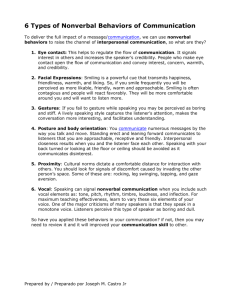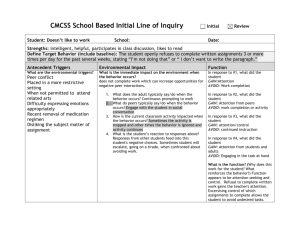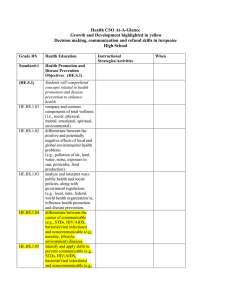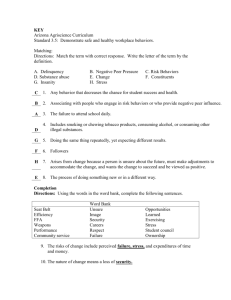Chapter 6, 8, 9
advertisement
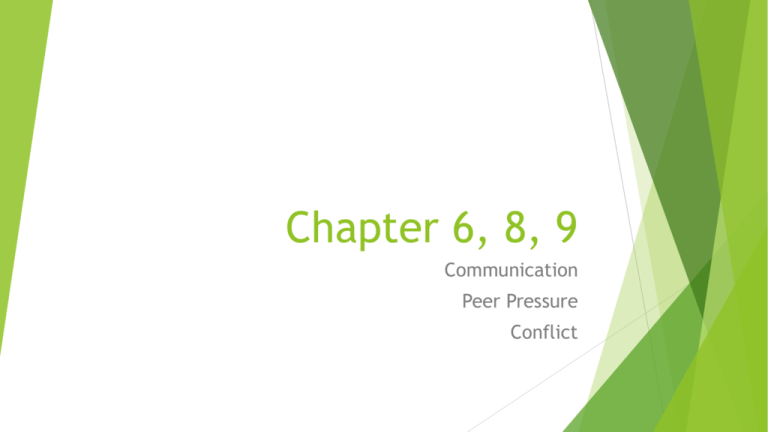
Chapter 6, 8, 9 Communication Peer Pressure Conflict Communication Styles Aggressive- overly forceful, pushy, or hostile Passive- unwilling or unable to express thoughts and feelings in a direct or firm manner Assertive- expressing your views clearly and respectfully Ways to Communicate Speaking Listening Nonverbal What are other ways of communicating? Which ways do you communicate the most? Speaking Skills The key to good communication is to say what you mean To ensure you do not sound disrespectful use “I” messages “I” message- a statement that focuses on your feelings rather then on someone else’s behavior They help you communicate your feelings in a positive way without placing blame EX: YOU- Why can’t you ever show up on time? I- I really don’t like to be left waiting- it makes me feel like you don’t think I’m important YOU TRY! Change the “YOU” messages into “I” messages: 1. You never listen to anything I say 2. I said I’d take out the trash, and I will! You don’t have to nag on me every five minutes! 3. You are always taking my clothes without asking. 4. You always ignore me when your other friends are around. 5. Why do you always have to bring that up? You always have to talk about the past, just end it!” Listening Skills Active listening- paying close attention to what someone is saying and communicating Don’t interrupt Show interest Restate Ask what you heard questions Show empathy Nonverbal Communication Body language- nonverbal communication through gestures, facial expressions, behaviors, and posture Other ways of nonverbal communication? Stack the Deck For this exercise, you will need a regular pack of playing cards and a lot of moving–around space. Blindfolds are optional (it takes a little longer). 1. Shuffle the deck of cards well and walk around the room to give each student a card. 2. Instruct the students to keep their cards a secret. No one can see the type or color of another's card. 3. Make it clear to students that they will not be able to talk during this exercise. 4. Instruct students to assemble into 4 groups according to suits (hearts, clubs, diamonds, spades) using nonverbal communication. 5. It's more fun to blindfold every student during this exercise. 6. Once students get into those groups, they must line up in order of rank, from ace to king. 7. The group that lines up in proper order first wins! HEADS UP! Peer Pressure Peer pressure- the influence that people your age may have on you Can have a positive or negative influence on your actions and behaviors POSITIVE: peers may inspire you to try a new activity, encourage you to participate in community projects, involves not participating in risky behaviors or activities NEGATIVE: may be disrespectful towar people they do not consider acceptable to their group. Harassment- persistently annoying others; may include hurtful behaviors such as name calling, teasing, or bullying. Engage in behaviors that go against their values Manipulation- an in direct, dishonest, way to control or influence other people -Making threats -Mocking or teasing -Black mail -Bargaining -Bribing -Guilt Trips -Flattery Resisting Negative Peer Pressure Develop friendships with people who share your values and interests Friends who have respect for your health and well-being will be less likely to pressure you into doing something that goes against your values You will also find that it is much easier to resist negative peer pressure when you have supportive friends who stand by you and respect your decision. Refusing to go along with a group may make them appear “uncool” Assertive Refusal Refusal Skills Steps 1. State you position- say no, and state your position simply and firmly 2. Suggest alternatives 3. Stand your ground- make it clear that you mean what you say, use strong body language, and maintain eye contact. If that still doesn’t work- walk away Practicing assertive communication is the most effective way to deal with peer pressure PRACTICE REFUSAL SKILLS Conflict Refers to any disagreement, struggle, or fight Conflicts between people or groups of people are known as interpersonal conflict Common causes: Power struggles Personal loyalties Jealousy and envy Property disputes Conflicting Lack attitudes and values of respect Responding to Conflict Compromise-an agreement or a settlement of a dispute that is reached by each side making concessions. Negotiation- the use of communication and, in many cases, compromise to settle a disagreement 1. Take time to calm down and think over the situation 2. Let each person take turns to express how they feel 3. Ask for clarification 4. Brainstorm solutions to the conflict 5. Discuss advantages and disadvantages to both sides 6. Agree on a solution 7. Follow up to ensure the solution has worked Preparing for Negotiation Choose the time and place carefully Check your facts Plan what you will say TIPS -Stay calm -Listen to each other -Attack the problem not each other -Take responsibility -Avoid blame or name calling -Open minded -Find a solution
